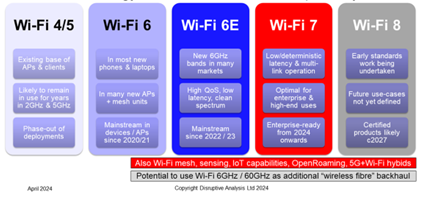
Why Managed Wi-Fi is Essential for Smaller Businesses
January 22, 2025 at 5:00 PM EST
Wi-Fi’s steady evolution has been nothing short of amazing. Since its launch in 1997 with a wireless data transmission capacity of up to 2 megabits per second, Wi-Fi technology, now in its seventh generation, is capable of transmission speeds up to 25 gigabits per second. As Wi-Fi technology has advanced, so have the applications. Some of the earliest use cases included connecting students on college campuses and enabling digital payment technologies. Wi-Fi’s “breakthrough moment” came in 1999 when Apple released the iBook laptop series, the first mass consumer product to offer Wi-Fi connectivity, which Apple marketed as AirPort.
In 2024, the annual economic value of Wi-Fi to the American economy was estimated at $1.6 trillion; by 2027, the industry will be worth about $2.7 trillion, a 33% increase in just 36 months. Much of Wi-Fi’s economic impact is generated by small- and medium-sized businesses (SMBs) that are deploying Wi-Fi for their employees, customers and visitors. For many SMBs, their Wi-Fi networks are the glue that holds their businesses together, whether through real-time employee collaboration, free and seamless internet access for guests and customers. Companies also benefit from the ability to scale their Wi-Fi networks and easily extend the business’s network.
Wi-Fi's Evolving applications and opportunities
Conventional Wi-Fi applications have focused on connecting users and devices to the business’s network and outside resources, including the internet. As Wi-Fi technology evolved from Wi-Fi 5 to Wi-Fi 6/6E and Wi-Fi 7, the performance regarding capacity, speed and coverage has continued to improve. Now, more ambitious minds are beginning to expand Wi-Fi’s use beyond communications., driven by the increasing need for enhanced Wi-Fi capabilities.
Wi-Fi sensing: As Wi-Fi signals travel, they bounce off physical objects, including people, creating subtle distortions in the signal patterns. These distortions can be analyzed to provide motion detection as a security function and premises security without cameras.
Power-over-Wi-Fi: The radio frequency (RF) signals emitted by Wi-Fi routers contain small amounts of power that can be harvested across the business and used to power small, low-energy devices such as sensors in IoT ecosystems.
Asset tracking: Using a process known as beaconing, a Wi-Fi-enabled device is constantly emitting signals that the network can use to pinpoint the location of the device, even if it’s not connected to the network.
Challenges
While Wi-Fi technology continues to provide advantages and opportunities for small- and medium-sized businesses, its rapid and continual development has created a number of thorny challenges for business owners.

As noted previously, Wi-Fi technology continues to evolve at a brisk pace. Wi-Fi 6 went mainstream around 2020. About two years later, Wi-Fi 6E was broadly adopted and integrated into mobile phones, tablets, and other devices. 12 months later, Wi-Fi 7 was deemed enterprise ready. Looking forward, Wi-Fi 8, which is so new that its use cases haven’t been fully identified, is expected to be integrated into access points and devices circa 2027. This rapid advancement means that companies, especially those that are not early adopters of new technologies, have very little time to acclimate to the latest Wi-Fi technology before it’s time to begin planning for the next generation.
That is not to say that a business must upgrade to the latest Wi-Fi technology when it becomes available. Wi-Fi 5 is considered outdated but is still widely used in SMBs. While it is doubtful that router and access point OEMs will stop supporting Wi-Fi 5 or 4 anytime soon, the difference between older generations and new ones, in terms of performance, functionality and network security, will prompt many SMBs to upgrade.
As difficult as it is for small business owners to try and keep pace with the changing technologies, the day-to-day management of even a modest-sized Wi-Fi network may be even more difficult. Much of the maintenance is focusesd on preventing unauthorized access, data theft, malware attacks, and other security risks. The task of maintaining Wi-Fi security and keeping it updated includes but is not limited to:
- Regularly updating router firmware
- Implementing strong encryption protocols
- Isolating guest networks
- Restricting access to the router
- Monitoring network traffic
- Educating employees about network security
- Securing the SSID (modify its name and default settings and turn off visibility to other users)
- Using WPA3 data encryption, the most advanced encryption currently available
- Setting up a firewall on each host
- Creating a dedicated file-sharing folder with controlled access
- Disabling full hard drive sharing and file sharing when it's not in use
- Regularly updating and applying patches to all wireless access points
- Using a Virtual Private Network to facilitate secure network connections for remote employees
Between having to keep up with network planning and upgrades and day-to-day IT maintenance, most business owners simply don’t have enough hours in the day to run their business and manage their Wi-Fi networks. And for most, hiring a full-time or even part-time network manager is not financially feasible. This is why SMBs are turning to a managed Wi-Fi service solution from third-party providers.
Managed Wi-Fi service
Managed Wi-Fi (also known as Wi-Fi-as-a-Service) enables an organization to outsource the tasks involved in designing, installing, maintaining, and monitoring its Wi-Fi network. The specific services provided vary but typically include tasks like conducting RF surveys, designing the network, procuring and deploying the equipment and necessary infrastructure, configuring and regularly updating software needed for operations and security, monitoring and troubleshooting network performance, and upgrading the network as necessary.
Offloading the day-to-day care and feeding of their Wi-Fi networks to a qualified network service provider enables the business to maintain optimal network status and a secure operating environment. More importantly, it lowers the total cost of network ownership while freeing management and staff to focus on business operations instead of managing the network. Instead of a large upfront CapEx expenditure, the business pays an affordable recurring monthly fee.
A more robust managed Wi-Fi program goes beyond network maintenance. It can provide valuable capabilities and insights that help you maximize employee productivity and better understand customer traffic patterns. A good example of this second-layer functionality can be seen in the Managed Wi-Fi Services program from Glo Fiber Business.
Glo Fiber Business Managed Wi-Fi services
At Glo Fiber Business, our SmartBiz Managed Wi-Fi solution provides all the baseline services you expect in a managed service solution. Your Glo Fiber Business Managed Wi-Fi services support team installs, configures, provisions and tests all necessary hardware and software. Once your network is up and running, we manage and maintain it for you. This includes continually updating its security capabilities and optimizing network speed, capacity, and latency performance.
This Managed Wi-Fi solution also unlocks the power of real-time analytics that enables you to track customer traffic patterns and visualize granular, user-level data to help optimize network and user performance to achieve your business goals. Using a powerful heuristics engine, we can rapidly identify anomalies impacting end users' experience across every stage of client connectivity - association, authentication, IP addressing, and DNS availability - for rapid root cause analysis and response.
Our Air Marshal intrusion prevention technology ensures round-the-clock protection and security from network vulnerabilities. Our wireless access points continuously and automatically scan your environment for cybersecurity threats and take preemptive action based on your preferences. For high-density environments, our Auto RF Optimization capabilities provide real-time and historical metrics that enable the system to dynamically adjust to handle increased traffic loads.
These additional features are designed to run transparently in the background, enabling you and your employees to focus on your business goals. You can easily see and track network performance and key traffic data and customize how your network operates from an intuitive dashboard.
Unlike many other managed network service providers, Glo Fiber Business owns and operates a local, full-service Network Operations Center (NOC). From here, we constantly monitor your Wi-Fi network 24 hours a day, 7 days a week, 365 days a year and proactively work to anticipate and prevent issues that may affect its performance and security.
With a Managed Wi-Fi program from Glo Fiber Business, even very small businesses can afford a robust, full-featured and secure Wi-Fi network, one that can help grow productivity, revenue and customer engagement. Glo Fiber Business makes it easy, offering all the essential business services to streamline operations, including voice and phone solutions to keep your communications streamlined and efficient
Click here to learn more about Managed Wi-Fi services from Glo Fiber Business.